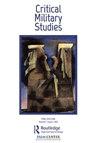Synching the martial body: poetic encounters with Finnish cadets
Q1 Arts and Humanities
引用次数: 0
Abstract
ABSTRACT In this paper, I engage poetically with embodied experiences of Finnish cadets in physical training, bringing the study of body technique, social emotions and militarism together. I focus on the cadets’ experiences in collective movement, in particular when synchronizing and attuning with each other. I identify three bodies – minded, machine and combat – as descriptions of being part of the synching collective. I propose that the interviewed Finnish cadets associate synchrony in their training with 1) the capacity and need to think with their bodies, 2) suffering as their social glue in an instrumentalist view of the body 3) techniques for surviving combat. I approach the material I collected in fieldwork through a poetics that echoes the cadets’ articulations through my own body, as well as writing speaking directly to cadets in the second person.同步的武身:诗意的邂逅芬兰学员
本文以芬兰军校学员在体育训练中的具体体验为切入点,将身体技术、社会情感和军国主义的研究结合在一起。我关注学员们在集体运动中的经验,特别是在同步和协调彼此的时候。我确定了三种身体——头脑、机器和战斗——作为同步集体的一部分的描述。我认为受访的芬兰学员将训练中的同步性与以下因素联系在一起:1)用身体思考的能力和需要;2)在身体的工具主义观点中,痛苦是他们的社会粘合剂;3)在战斗中生存的技巧。我通过一种诗学的方式来处理我在田野调查中收集到的材料,这种诗学通过我自己的身体来回应学员的发音,以及以第二人称直接对学员说话。
本文章由计算机程序翻译,如有差异,请以英文原文为准。
求助全文
约1分钟内获得全文
求助全文
来源期刊

Critical Military Studies
Arts and Humanities-History
CiteScore
1.90
自引率
0.00%
发文量
20
期刊介绍:
Critical Military Studies provides a rigorous, innovative platform for interdisciplinary debate on the operation of military power. It encourages the interrogation and destabilization of often taken-for-granted categories related to the military, militarism and militarization. It especially welcomes original thinking on contradictions and tensions central to the ways in which military institutions and military power work, how such tensions are reproduced within different societies and geopolitical arenas, and within and beyond academic discourse. Contributions on experiences of militarization among groups and individuals, and in hitherto underexplored, perhaps even seemingly ‘non-military’ settings are also encouraged. All submitted manuscripts are subject to initial appraisal by the Editor, and, if found suitable for further consideration, to double-blind peer review by independent, anonymous expert referees. The Journal also includes a non-peer reviewed section, Encounters, showcasing multidisciplinary forms of critique such as film and photography, and engaging with policy debates and activism.
 求助内容:
求助内容: 应助结果提醒方式:
应助结果提醒方式:


